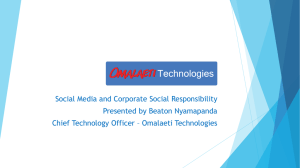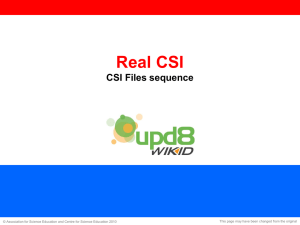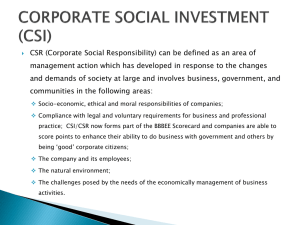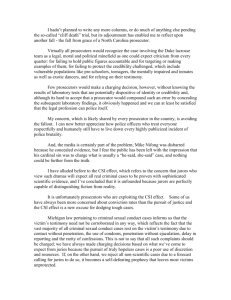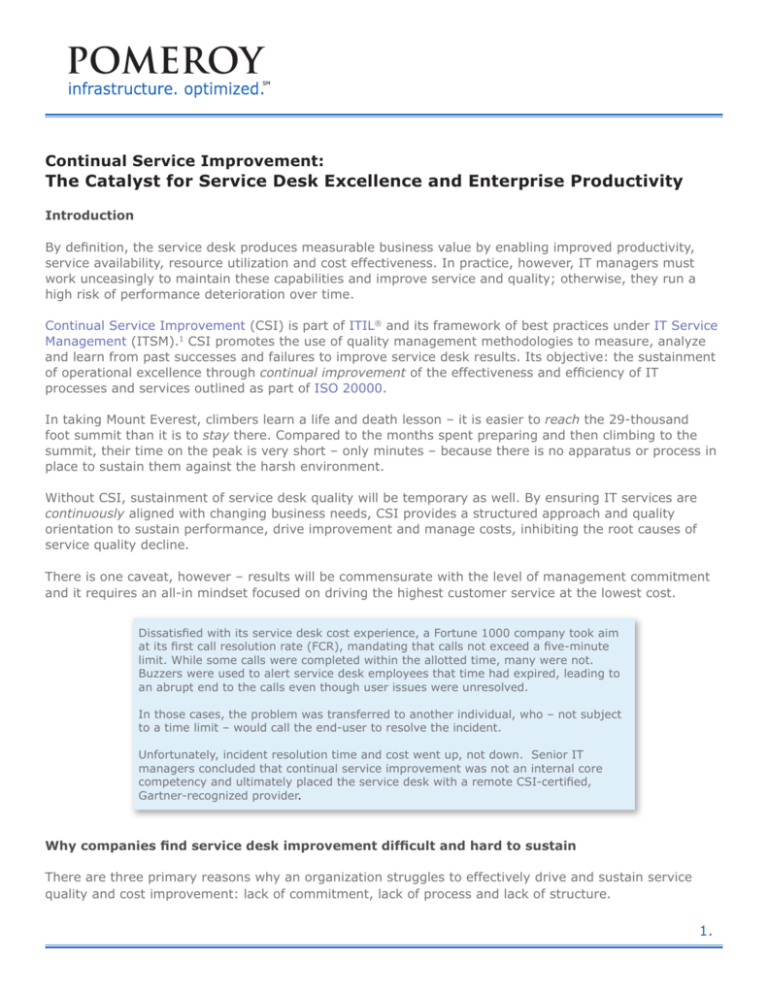
Continual Service Improvement:
The Catalyst for Service Desk Excellence and Enterprise Productivity
Introduction
By definition, the service desk produces measurable business value by enabling improved productivity,
service availability, resource utilization and cost effectiveness. In practice, however, IT managers must
work unceasingly to maintain these capabilities and improve service and quality; otherwise, they run a
high risk of performance deterioration over time.
Continual Service Improvement (CSI) is part of ITIL® and its framework of best practices under IT Service
Management (ITSM).1 CSI promotes the use of quality management methodologies to measure, analyze
and learn from past successes and failures to improve service desk results. Its objective: the sustainment
of operational excellence through continual improvement of the effectiveness and efficiency of IT
processes and services outlined as part of ISO 20000.
In taking Mount Everest, climbers learn a life and death lesson – it is easier to reach the 29-thousand
foot summit than it is to stay there. Compared to the months spent preparing and then climbing to the
summit, their time on the peak is very short – only minutes – because there is no apparatus or process in
place to sustain them against the harsh environment.
Without CSI, sustainment of service desk quality will be temporary as well. By ensuring IT services are
continuously aligned with changing business needs, CSI provides a structured approach and quality
orientation to sustain performance, drive improvement and manage costs, inhibiting the root causes of
service quality decline.
There is one caveat, however – results will be commensurate with the level of management commitment
and it requires an all-in mindset focused on driving the highest customer service at the lowest cost.
Dissatisfied with its service desk cost experience, a Fortune 1000 company took aim
at its first call resolution rate (FCR), mandating that calls not exceed a five-minute
limit. While some calls were completed within the allotted time, many were not.
Buzzers were used to alert service desk employees that time had expired, leading to
an abrupt end to the calls even though user issues were unresolved.
In those cases, the problem was transferred to another individual, who – not subject
to a time limit – would call the end-user to resolve the incident.
Unfortunately, incident resolution time and cost went up, not down. Senior IT
managers concluded that continual service improvement was not an internal core
competency and ultimately placed the service desk with a remote CSI-certified,
Gartner-recognized provider.
Why companies find service desk improvement difficult and hard to sustain
There are three primary reasons why an organization struggles to effectively drive and sustain service
quality and cost improvement: lack of commitment, lack of process and lack of structure.
1.
As fundamental as it sounds, CSI begins and ends with leadership and commitment – a top-down,
bottom-up mindset that extends from senior management to the analysts on the front lines.
Commitment means setting high expectations for service and quality, regular reporting on KPIs and
ongoing improvement initiatives, a high priority on customer service, and individual accountability
for results. Commitment also must make provision for a standardized, process-driven methodology
and the support structure required to accomplish performance goals.
Process and structure are the means to an end and they define the organization and resources
required to achieve desired outcomes. Many companies’ service desks, however, have evolved
in patchwork fashion around legacy IT systems and processes, built up over time without the
disciplines of clear strategy, operational focus and effectiveness criteria. As a result performance
is often supported by little more than super-sized help desk transactional processes incapable of
effectively diagnosing recurring user issues, capturing and applying new learning, and adapting
processes to improve results.
Turning that around requires qualified CSI leadership and, in most organizations, that includes
one or more individuals in management and team leadership roles who are ITIL certified at
the intermediate or, better yet, at the ITIL Expert or Master levels. They embody the ITIL
methodology, best practices and leadership requirement necessary to embed process improvement
into ITSM processes.
Without a deterministic process and commitment to continual improvement – including dedicated
CSI resources – organizations will lack confidence in their environments and capabilities – what
is working and what isn’t, how to measure effectiveness, where and how to make needed
improvements, and sustain them.
A Midwestern U.S. manufacturer discovered its service desk relied upon a
complicated ticket classification system, with 1,871 ticket codes based upon a
monthly volume of 10,000 tickets. This ratio was unacceptably high and was
indicative of needless complexity, ineffective root cause analysis and impaired
ability to resolve user issues quickly.
CSI analysis determined that 1,293 codes were unnecessary (69% reduction),
resulting in 50% fewer costly, misdirected and escalated tickets, and improved
end-user satisfaction.
Deploying the CSI methodology
Continual Service Improvement is not a discrete service or solution in a box. It is equal parts
an overarching quality framework and an applied mindset as opposed to a fixed set of tools or
detailed instructions specifying what to do when. CSI is effective in driving improvement because
it is embedded in every service desk process, permeating every action, application and desired
outcome.
Providing structure, CSI organizes around a framework of four distinct process areas designed
to review and evaluate key processes and services, and to manage the progress of improvement
initiatives.
2.
CSI Process
Objectives
Key Performance Indicators
Service Review
•
Review business and infrastructure
services to improve quality and cost
•
•
Service Reviews conducted
Weaknesses identified
Process Evaluation
•
Evaluate processes on a regular
basis
Identify areas where metrics are not
being met
Conduct regular audits to improve
processes and services
•
•
•
•
Benchmarking, audits and assessments
conducted
Evaluations conducted
Weaknesses identified
Initiatives completed
•
•
Definition of CSI Initiatives
•
Define initiatives to improve
processes and services
•
•
Initiatives in process
Initiatives completed
Monitoring of CSI Initiatives
•
Verify initiatives are on plan
•
•
Initiatives at or behind plan
Corrective measures applied
Against this framework are applied CSI best practices and tools that will improve the quality
of service on a consistent basis, delivering real value to the bottom line in terms of increased
productivity and cost efficiency.
• Standard ITSM methodology
• Econometrics-driven decision making
• Knowledge Management, or Knowledge
Centered Support (KCS™)
The standard approach most often employed is the ITIL V3 7-Step CSI process, a deterministic,
data-driven methodology that provides the roadmap for identifying opportunities, improving
performance and reducing cost.
The ITIL V3 7-Step CSI Process
Applying the CSI methodology involves detecting, analyzing, evaluating, identifying and
acting upon improvement opportunities with return on investment potential. The last steps in
implementing corrective actions to a process also include the establishment of new performance
baselines as well as process validation. These steps ensure the new changes being implemented
are seamless and deliver the expected improvement.
Despite the linear depiction in the above illustration, the CSI process is designed to be an ongoing,
continuous loop – as one improvement cycle ends, the next cycle begins anew to measure and
evaluate all processes within the ITSM environment.
• Incident Resolution - restoring normal
operations quickly
• Access Management - managing user
rights to services
• Service Request Fulfillment - managing
user requests
• Problem Management - minimizing
impacts resulting from errors
• Asset Management - tracking asset
lifecycle value
• Change Management - controlling
changes to minimize impact
3.
A top 25 financial services institution struggling to absorb hundreds of newlyacquired branches saw its service desk KPIs going the wrong direction, along with
costs and end-user satisfaction.
CSI methodology proved critical in root cause analysis, re-engineering processes
and driving out cost, leading to a significant reduction in cost per call (40%),
improvement in first call resolution rate (37%) and increased end-user
satisfaction (31%).
The reactive and proactive sides of continual improvement
In practice, CSI occurs both reactively and proactively in an organization and that is important
because an integrated team of people at different points in the process identify issues, analyze root
causes, implement solutions and capture new learning for the service desk knowledge database.
Much of what occurs at the service desk is reactive by design – responding to end-user phone calls,
e-mails, live chat, web forms and self-service tickets. A problem is documented, a dashboard
metric has turned yellow, or too many tickets are being escalated to costly, time-consuming
resolver groups.
In fielding dozens of calls and contacts a day, the level one analyst efficiently resolves most routine
incidents, but will escalate those he can’t resolve to a more experienced level two analyst. Analysts
are expected to “own” the contact and to troubleshoot and resolve as many issues as possible at
the service desk using all available knowledge tools and coaching support. Escalating to 2nd or
3rd level support may follow if hands-on deskside resolution or specialized application support is
required.
Throughout this sequence of escalation, data is collected at each stage of the process for
examination by CSI analysts to improve incident handling in the future or, better yet, prevent
similar incidents from occurring altogether.
The CSI-driven Service Desk - Roles and Responsibilities
Service Level Manager
(SLM)
CSI and KCS Process
Analysts
• Directs all service
desk activity
• Works with Client and
Business Relationship
Manager to meet
Service Level
Agreements (SLAs)
• Analyze support
processes to
identify efficiency and
continual
improvement
opportunities
• Manage and maintain
central knowledge
database used for
support services
• Build training content
for client specific
needs
Service Desk Analysts
• Provide first level
support for inbound
service requests
• Provide second level
support for escalated
issues
• Deliver access and
problem management
services
Business Relationship
Manager
• Works closely with
Client and program
managers
• Generates and
delivers reporting and
identifies
improvement
opportunities
From a proactive perspective, CSI analysts are tasked with taking a longer view, performing formal
quarterly reviews of the service desk, or individual reviews for each desk within a multi-tenant
remote environment to identify areas for improvement. Even if a client’s Service Level Agreement
4.
does not specify productivity and process improvement goals – which it should – CSI analysts
are charged with identifying opportunities, making recommendations and implementing a Service
Improvement Plan.
The value of data to cost and productivity improvement
The service desk is a data rich environment and econometrics-driven decision making is used to
analyze vast amounts of raw data in order to identify efficiency improvements, measure impact,
build a business case for improvement initiatives and quantify expected ROI.
When an inbound contact occurs, the service desk immediately identifies the user, location and all
related user-computer information. This data can be tied together and analyzed to determine what
is happening in the environment and why it may be generating calls to the service desk. Every call
and contact are recorded and documented, and a representative sample of screen shots captured
to facilitate thorough call quality, ticket quality and incident resolution analysis.
Econometrics-driven decision making drives out costs
by finding better ways to resolve more calls at the
service desk in less time with fewer service exceptions
and escalations through improved processes and
technology. With the wealth of available service desk
data, root cause analysis is conducted to make sure
causes, not symptoms, are addressed, illustrated here
by the isolation of issues related to poor ticket and
incident coding.
Ticket routing and incident categorization
measures identified for future analysis
By applying sophisticated mathematical and statistical
techniques against incident data – cluster analysis, trend analysis, word frequency analysis, etc. –
CSI-certified analysts determine why, for example, first call resolution varies by ticket type, or on a
larger scale, how the environment will need to change before a client can effectively migrate from a
traditional high cost, on-premise support model to a lower cost, self-service model.
CSI is key to identifying the changes in the environment needed to adopt a more
responsive, cost effective service desk model.
Finally, econometrics-driven reporting and trend analysis often are used on a regular basis to
provide service desk analysts with feedback and coaching on call and ticket handling, and to
identify areas for employee skill and career development, including ITIL and CSI training and
certification.
5.
A Fortune 50 global consumer products company decided to consolidate several
autonomous and siloed North American operating companies’ service desks. The
goal: to evolve to a more balanced, cost-efficient and end-user-oriented self
service model supporting over 56,000 end-users.
Despite some initial organizational resistance, call volume decreased 50% and
costs fell 20% in the first two years of deployment. CSI identified both low
hanging fruit and long-term process improvements as part of an ongoing, multiphase transformation to drive improved performance, end-user satisfaction and
lower costs.
Out of shared knowledge comes enhanced productivity, improved service
The service desk isn’t immune to the idea that those who fail to learn from the mistakes of the
past are destined to repeat them. Unfortunately, too many organizations fail to capture data and
document lessons learned from the thousands of incidents that could be used to improve future
results.
Knowledge Centered Support (KCS) is a key building block of continual improvement and it
provides an important framework and strategy for capturing, organizing and sharing service desk
knowledge. In practice, KCS becomes a central knowledge database providing best practices to
improve incident management, problem management and other service desk operations.
When the analyst captures information related to an incident and documents how it was resolved,
it becomes part of a knowledge database, immediately available to other analysts and providing
environment-specific information to resolve similar incidents. In time all newly-added information is
vetted – validated by other analysts as a trustworthy approach to use. Automated and specialized
knowledge base support tools, such as RightAnswers® or CA Technologies®, provide end-user selfservice options and enable analysts to quickly identify, diagnose and resolve user issues with any of
hundreds of applications.
In a remote multi-tenant service desk environment, the ability of KCS to solve problems faster
and more predictably is multiplied due to the effective cross-pollination of incident and problem
management data. Leveraging lessons learned in one client’s environment helps resolve issues in
another in a fraction of the time and cost. As a result, more issues are resolved faster, and with
fewer escalations that would add time, cost and reduce end-user satisfaction.
A Fortune 1000 manufacturing client experienced longer than normal wait times
during peak periods resulting in an unacceptably high call abandon rate – callers
hanging up before being given an opportunity to leave a voice message and enter
a queue for a return call from the Service Desk.
CSI analysis determined the optimum length of time a caller would wait to leave
a message. The ACD system was reprogrammed, shortening the wait time by
15 seconds, immediately improving the abandon rate by 25% along with overall
customer satisfaction.
6.
Final thoughts
CSI must be embraced by senior IT leadership as an internal core competency before an
organization stands a good chance of increasing user satisfaction, driving productivity, reducing
costs – and sustaining improvement. Without question, access to actionable data and the
development of knowledge management are also key indicators of how capable a company will be
in driving Continual Service Improvement.
Organizations where CSI is not an internal competency may evaluate on-premise or remote
third party service desk support. Key considerations should include CSI and HDI certifications,
the availability of a robust knowledge management infrastructure, industry references, analyst
recognition, and a track record of productivity and cost improvement and end-user satisfaction that
consistently surpasses frequently quoted (and sub-optimal) industry averages.
More is expected of the outside service desk provider because this is their core competency and it
will be accountable for delivering agility, flexibility, scalability and that speed-to-solution mindset
required to improve productivity, reset the bar and repeat the CSI process over and over again.
In the final analysis, it may matter less whether an organization integrates CSI into an on-premise
or a remote service desk operation as long as it is managed to achieve the high expectations of
continual improvement at the lowest cost. In either case, CSI will consistently deliver a measurable
return on investment and customer satisfaction, year over year.
About Pomeroy
Pomeroy provides high quality managed IT infrastructure services, professional and staffing
services and procurement and logistics services to Fortune 500 corporations, global outsourcers
and the public sector throughout the U.S., Canada and Europe. A recognized leader in the service
desk and managed desktop services markets, Pomeroy’s ITIL, CSI and HDI certified professionals
employ a process-centric approach to working with clients, either remotely or on-premise, to
plan, design, deploy, manage and ultimately optimize each client’s IT infrastructure, leading to the
creation of tangible business value and return on IT investments.
Learn more at www.pomeroy.com.
Would you like to learn more about the clients profiled in this white paper? Click here.
1
ITIL V3 CSI – Continual Service Improvement, http://wiki.en.it-processmaps.com/index.php/ITIL_V3_CSI_-_Continual_
Service_Improvement.
© Pomeroy, 2012. All rights reserved. All trademarks, trade names, service marks referenced herein are the property of
their respective companies. V1612.
7.

